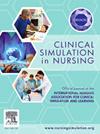医疗保健专业人员与学生模拟现实度量表:发展、效度与信度研究
IF 2.5
3区 医学
Q1 NURSING
引用次数: 0
摘要
模拟中的现实主义显著影响教育结果,但没有标准化的工具来评估参与者的看法。开发一种工具来衡量它们的逼真程度,将增强模拟的设计,使它们更容易评估并提高其质量。目的:本方法学研究旨在开发和验证模拟现实主义量表(SRS),供医疗保健专业人员和学生使用。方法采用Morgado等(2017)的三阶段方法编制21项量表。372名参与者根据INACSL指南参加了标准化模拟。确保语言和内容的有效性。用CFA检验结构效度;信度采用Cronbach’s alpha (α)、项目-总相关和重测进行检验。结果CFA证实了一个五因素结构,解释了65%的方差。Cronbach’s α值为0.91。SRS是一种可靠、有效的工具,用于测量基于模拟的医疗保健教育中的感知现实性。结论建议在不同文化背景下进一步验证。本文章由计算机程序翻译,如有差异,请以英文原文为准。
The simulation realism scale for healthcare professionals and students: A development, validity and reliability study
Introduction
Realism in simulations significantly influences educational outcomes, yet there is no standardized tool to assess participants' perceptions. Developing a tool to measure how realistic they are will enhance the design of simulations, make them easier to evaluate and improve their quality.
Aims
This methodological study aimed to develop and validate the Simulation Realism Scale (SRS) for use by healthcare professionals and students.
Methods
A 21-item scale was developed using Morgado et al.’s (2017) three-stage approach. Three hundred and seventy-two participants participated in standardized simulations according to the INACSL guidelines. Language and content validity were ensured. Construct validity was tested with CFA; reliability was tested with Cronbach's alpha (α), item-total correlations, and test-retest.
Results
The CFA confirmed a five-factor structure explaining 65% of variance. The Cronbach’s α value was 0.91.
Discussion
The SRS is a reliable, valid tool for measuring perceived realism in simulation-based healthcare education.
Conclusions
Further validation across different cultures is recommended.
求助全文
通过发布文献求助,成功后即可免费获取论文全文。
去求助
来源期刊

Clinical Simulation in Nursing
NURSING-
CiteScore
5.50
自引率
15.40%
发文量
107
期刊介绍:
Clinical Simulation in Nursing is an international, peer reviewed journal published online monthly. Clinical Simulation in Nursing is the official journal of the International Nursing Association for Clinical Simulation & Learning (INACSL) and reflects its mission to advance the science of healthcare simulation.
We will review and accept articles from other health provider disciplines, if they are determined to be of interest to our readership. The journal accepts manuscripts meeting one or more of the following criteria:
Research articles and literature reviews (e.g. systematic, scoping, umbrella, integrative, etc.) about simulation
Innovative teaching/learning strategies using simulation
Articles updating guidelines, regulations, and legislative policies that impact simulation
Leadership for simulation
Simulation operations
Clinical and academic uses of simulation.
 求助内容:
求助内容: 应助结果提醒方式:
应助结果提醒方式:


